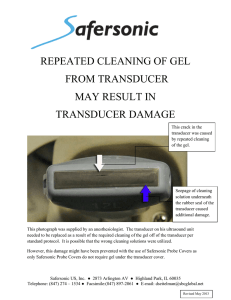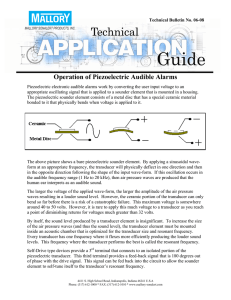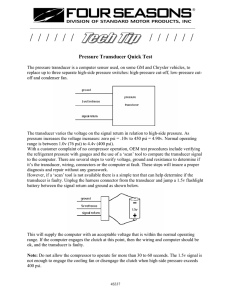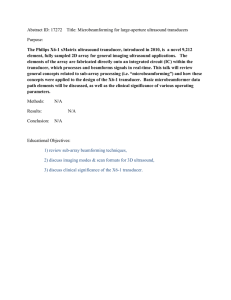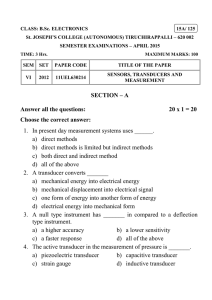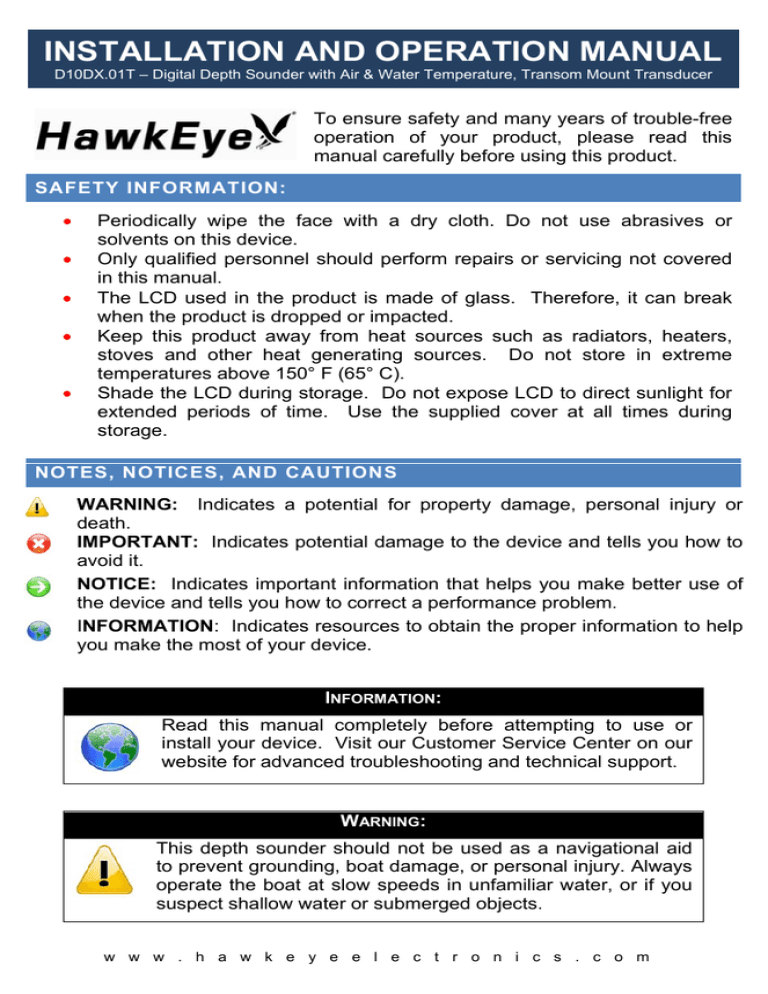
Model No. D10D
INSTALLATION AND OPERATION MANUAL
D10DX.01T – Digital Depth Sounder with Air & Water Temperature, Transom Mount Transducer
To ensure safety and many years of trouble-free
operation of your product, please read this
manual carefully before using this product.
SAFETY INFORMATION:
•
•
•
•
•
Periodically wipe the face with a dry cloth. Do not use abrasives or
solvents on this device.
Only qualified personnel should perform repairs or servicing not covered
in this manual.
The LCD used in the product is made of glass. Therefore, it can break
when the product is dropped or impacted.
Keep this product away from heat sources such as radiators, heaters,
stoves and other heat generating sources. Do not store in extreme
temperatures above 150° F (65° C).
Shade the LCD during storage. Do not expose LCD to direct sunlight for
extended periods of time. Use the supplied cover at all times during
storage.
NOTES, NOTICES, AND CAUTIONS
WARNING: Indicates a potential for property damage, personal injury or
death.
IMPORTANT: Indicates potential damage to the device and tells you how to
avoid it.
NOTICE: Indicates important information that helps you make better use of
the device and tells you how to correct a performance problem.
INFORMATION: Indicates resources to obtain the proper information to help
you make the most of your device.
INFORMATION:
Read this manual completely before attempting to use or
install your device. Visit our Customer Service Center on our
website for advanced troubleshooting and technical support.
WARNING:
This depth sounder should not be used as a navigational aid
to prevent grounding, boat damage, or personal injury. Always
operate the boat at slow speeds in unfamiliar water, or if you
suspect shallow water or submerged objects.
w w w . h a w k e y e e l e c t r o n i c s . c o m
PARTS SUPPLIED IN PACKAGING
The following parts should be included with the display:
•
•
•
•
•
•
•
Digital Depth Sounder Display
White and Black Faces and Bezels (optional on some models, see
package for details)
Display Sun Cover (optional on some models, see package for details)
Thick Dash Extension Rod (optional on some models, see package for
details)
Flush Mount Bracket and Hardware
Display Power Harness and Waterproof Fuse Holder Attached to the Unit
Air Temperature Sensor and Harness Connected to the Display
The following parts should be included with the transducer:
•
•
•
•
•
•
•
Transom Mount Transducer with Integrated Temperature Sensor, 30 ft
Cable and Connectors
Transducer Support Bracket with Attached Kick-Up Bracket
(2) Tapered Plastic Shims
(2) Cable clamps
Clam Shell Cable Cover
(2) #10 x 1.25” self-tapping screws
(4) #6 x 1/2” self-tapping screws
If any items are missing or damaged, please contact our customer service
department.
SELECTING THE PROPER TRANSDUCER INSTALLATION
The D10DX is available with either a Transom Mount (D10DX.01T) or a Plastic
Thru Hull (D10DX.06T) Transducer. This package includes a transom mount
transducer that can ONLY be Transom Mounted.
The Transom Mount transducer (D10DX.01T) is suitable for the following
vessels:
• Outboard, inboard/outboard, single inboard, or jet-drive propulsion.
• Hull dead rise angle below 30°.
• Transom angle from 3-20°.
The Thru Hull Transducer (D10DX.06T) is suitable for the following vessels:
• Outboard, inboard/outboard, single or dual inboard, or jet-drive
propulsion.
• Hull dead rise angle below 20°.
• Fiberglass or Metal Hull Material. CANNOT be constructed of wood.
• Hull thickness LESS than 1.25” (32 mm)
w w w . h a w k e y e e l e c t r o n i c s . c o m
If you think that the transom mount transducer is not suitable for your installation,
return to the place of purchase and exchange for the thru-hull (D10DX.06T). You
can also visit our Customer Service Center at www.hawkeyelectronics.com to
contact us or to complete a transducer exchange request to exchange the
transducer for one that is specialized for your vessel. You may also call 888766-7276 to inquire about exchanging the transducer.
INSTALLING THE DISPLAY
Tools & Supplies Required for Installation
•
•
•
•
•
Electric Drill
2” Hole Saw
Wire Connectors Suitable for Connecting the Power Wire to Your Vessel
Wire Cutting/Crimping Tool
Marine Sealant/Caulk
STEP 1
Installing the Display
1. Find a location on the boat that will allow clear viewing of the display. Keep
in mind that the wires for the transducer and power must reach the mounting
location.
2. After finding the right location, mark a 2-inch hole. (If your boat has a pre-cut
hole in the dash panel, simply remove the hole plug and proceed to Step 5.)
IMPORTANT:
Check behind the desired cutting area for wires, switches, etc. that
may be damaged during cutting. If these obstructions are present,
use masking tape to hold them out of the way during cutting.
3. Cut out the 2-inch hole using the 2” hole
saw.
4. Seal any exposed wood with a marine
sealant.
5. Insert the display from the front of the panel,
feed the wires through the bracket and install
the bracket and locking nut from the rear of
the panel. Make sure that the face of the
display is rotated upright and aligned to your
satisfaction for easy viewing from the
vessel’s helm.
w w w . h a w k e y e e l e c t r o n i c s . c o m
NOTICE:
The display can also be surface mounted using
the Adjustable Surface Mount Bracket (1000-10).
Please visit our website or contact us by phone
for purchase information. You must attach the
extension rod to the mounting stud on the back of the display housing
before inserting the display into the Surface Mount Bracket.
STEP 2
Installing the Face and Bezel
1. Place the face (B) over the display making
sure to line up the cut outs on the face with
the notches on the display.
2. While holding the bezel (A), place it over
the display and turn clockwise until the
bezel locks into place.
NOTICE:
Gold and Chrome Alloy Bezels can be purchased on our
website to match your factory dash or give your Digital Depth
Sounder a custom appearance (P/N: 1000.20, 1000.22).
STEP 3
Installing the Air Temperature Sensor
The air temperature sensor is already installed on the back of the display housing
and includes a short harness.
• To install simply route the wire so that the end is located in the area
where you would like to take air temperature readings.
• Keep in mind that the sensor is located at the end of the harness and
should be kept away from direct sunlight, enclosed compartments, and
external heat sources.
NOTICE:
The water temperature sensor is located in the transducer. It
will be installed and connected during the transducer
installation process.
w w w . h a w k e y e e l e c t r o n i c s . c o m
STEP 3
Connecting of the Power Cable
The display has no ON/OFF switch. Therefore, you will
need to connect the power harness to a power source that
will turn the unit on as power is applied. The key switch or
an ON/OFF power switch will be suitable for powering the
unit.
1. Connect the BLACK wire in the harness to a negative (-)
terminal or suitable ground.
2. Connect the RED wire in the harness to a positive (+) 12
Volt switchable power source (key switch, on/off switch,
terminal block, etc).
NOTICE:
Never use “Twist-On” or “Automotive” type
connectors. Use ONLY connectors designed for the
marine environment. These connectors form a solid
electrical connection and are less likely to corrode.
STEP 4
Testing the Display Installation
Before continuing with your installation, you
should test the unit to make sure the power wires
are properly attached.
1. Apply power to the unit by turning on the
power source that you’ve attached the red
and black wires to.
2. The buzzer should beep three times while the display
illuminates all the LCD graphics for 2 seconds. “---”
will then be shown on the LCD.
If the display operates as per #2 above, continue to the
“Basic Operation” section.
If the display does not turn ON:
1. Check the power source using a test light or DC volt
meter. Make sure there is 12 volt power where the
power harness connects to both the positive and
negative sources.
2. Check the fuse holder assembly with a test light or DC
volt meter. Connect the ground for the test meter or
light to the vessel’s negative power source.
w w w . h a w k e y e e l e c t r o n i c s . c o m
3. Remove the fuse and check for 12 volt power at the spring located inside the
fuse housing that is connected to the vessel’s power source. If 12 volt power
is present continue to the next step. If power is not present, return to Step 1.
4. Insert the fuse and check for 12 volt power at the end of the fuse. If 12 volt
power is present continue to Step C. If power is not present, replace the
fuse.
5. Reassemble the fuse housing. Strip back a quarter of an inch of wire cover
on the display side of the fuse housing and test for 12 volt power. If 12 volt
power is present continue to Step 2.D. If power is not present, replace the
fuse housing assembly.
6. Visit our Customer Service Center on our website or call 888-766-7276 for
advanced technical support.
NOTICE:
The fuse used in the In Dash Depth Sounder is a .25A, 250V
fuse. Do not rely on a visual inspection of the fuse to determine
if it is functioning. If your depth sounder will not turn on,
ALWAYS test the fuse with a test light or voltage meter.
GETTING TO KNOW YOUR DIGITAL DEPTH SOUNDER DEPTH
The unit’s auto-ranging, auto-sensitivity features means
that you never have to worry about adjustments. Simply
turn the power on, and you’re ready to go. The Depth
Sounder emits sound signals that travel through water, and
then calculates the amount of time that elapsed while the
signal traveled down to the bottom and returned back to
the transducer. This time is calculated by the microprocessor and displayed as a
depth reading. Extremely dirty water, very soft bottom, high speeds, deep water,
or a combination of the above will result in incomplete or inaccurate readings.
Under these conditions variable readings or “- - -” will be displayed.
NOTICE:
This depth sounder has a non-volatile memory. ALL
settings will be stored when the power is turned OFF.
DISPLAY MODE SELECTION
The unit has 3 user selectable modes:
• Depth Sounder
• Water Temperature
• Air Temperature
w w w . h a w k e y e e l e c t r o n i c s . c o m
To Change the Mode:
1. Press the “UP” Button to change the mode to the Right (The display will
change modes from Depth to Water Temperature to Air Temperature)
2. Press the “DOWN” Button to change the mode to the Left (The display
will change modes from Depth to Air Temperature to Water
Temperature)
NOTICE:
When a Temperature Mode is selected the Water or
Air indicator will flash on the LCD for 5 seconds while
the temperature is calculated.
SHALLOW WATER ALARM
The shallow alarm function can be set for depths ranging from 3 to 200 feet and
triggers an alarm when the depth is less than the setting. You must be in the
“Depth Sounder” mode to adjust this setting.
To set the SHALLOW ALARM (upper alarm):
1. Press and hold the "UP" and “DOWN” keys until
the
and
indicators illuminate and the
icon blinks. (approximately 3 seconds).
2. Release the Keys.
3. Press the "UP" key to access the shallow water
alarm setting. The
icon will illuminate and the
indicator will blink.
4. Pressing the "UP" key will increase the selected value. Pressing the "DOWN"
key will reduce the value.
5. Pressing and releasing the key will change the value in 1-foot increments per
second.
6. Holding down the key will change the value in 9 foot increments per second.
7. After the desired setting is achieved, the display will return to normal
operation after 5 seconds.
8. The
and
indicators will now be illuminated to indicate that a shallow
water alarm is set.
When triggered, the alarm sounds an audible buzzer for ten seconds while
flashing the warning LED and the
and
icons on the display. After 10
seconds, the audible alarm mutes and the warning LED and the
and icons
continue to blink until the depth increases, or the alarm is reset. To reset the
alarm repeat steps 1 thru 5.
w w w . h a w k e y e e l e c t r o n i c s . c o m
DEEP WATER ALARM
The deep alarm function can be set for depths ranging from 3 to 200 feet and
triggers an alarm when the depth is more than the setting. You must be in the
“Depth Sounder” mode to adjust this setting.
To set the DEEP ALARM (lower alarm):
1. Press and hold the "UP" and “DOWN” keys until
the
and
indicators illuminate and the
icon blinks. (approximately 3 seconds).
2. Release the Keys.
3. Press the "DOWN" key to access the deep
water alarm setting. The
icon will illuminate
and the
indicator will blink.
4. Pressing the "UP" key will increase the selected
value. Pressing the "DOWN" key will reduce the value.
5. Pressing and releasing the key will change the value in 1-foot increments per
second.
6. Holding down the key will change the value in 9 foot increments per second.
7. After the desired setting is achieved, the display will return to normal
operation after 5 seconds.
8. The
and
alarm is set.
indicators will now be illuminated to indicate that a deep water
When triggered, the alarm sounds an audible buzzer for ten seconds while
flashing the warning LED and the
and
icons on the display. After 10
seconds, the audible alarm mutes and the warning LED and the
and icons
continue to blink until the depth increases, or the alarm is reset. To reset the
alarm repeat steps 1 thru 5.
KEEL OFFSET
The Keel Offset feature is used to
adjust
the
depth
readings
displayed by the device to
compensate for the depth of the
water required for your vessel to
operate safe (typically referred to
as your vessel’s “Draft”)
DRAFT
For Example: If your boat’s draft is 3 feet, the Keel Offset feature should be set
to 3 feet. The device will then subtract 3 feet from the actual depth reading and
display this figure as the depth. If the water depth is 5 feet and the Keel Offset is
set to 3 feet, the depth will be displayed as 2 feet, indicating to the operator that
there is 2 feet of safe operating water.
w w w . h a w k e y e e l e c t r o n i c s . c o m
The maximum Keel Offset setting is 20 FT (6.1 M), and can be set in .1 (1/10th)
Feet or Meter increments. The unit will read “---” when a negative value occurs
due to the Keel Offset subtraction.
To set the Keel Offset:
1. Press and hold the "UP" and “DOWN” keys
until the K/O indicator begins to blink.
(approximately 6 seconds).
2. Release the Keys.
3. Press the "UP” key to increase the Keel Offset
value. Press the "DOWN" key to reduce the
value.
4. The display will return to the normal operation
mode after five seconds if no keys are pressed.
5. “K/O” will remain illuminated in the top left hand
corner indicating that the depth readings are
adjusted to the Keel Offset setting.
UNITS OF MEASURE
The units of measure for the depth readout and alarm functions can be set in 4
easy steps. The two settings available are Feet (FT) and Meters (M). You must
be in the “Depth Sounder” mode to adjust this setting.
To Set the Units of Measure:
1. Press and hold the "UP" and “DOWN” keys
until the current unit of measure begins to blink.
(approximately 8 seconds).
2. Release the Keys.
3. To set the units to FEET press the “UP” key.
“FT” will flash on the Display.
4. To set the units to METERS press the “DOWN”
key. “M” will flash on the Display.
5. The display will return to the normal operation mode automatically after five
seconds.
IMPORTANT:
Install and test the display in the desired
mounting location before attempting the
transducer installation.
w w w . h a w k e y e e l e c t r o n i c s . c o m
MOUNTING THE TRANSDUCER
Tools & Supplies Required for Installation
•
•
•
•
•
•
•
•
•
•
•
Power Drill
3/4”” (19 mm) drill bit, hole saw or spade bit
1/8” (3 mm) drill bit
9/64” (4 mm) drill bit
Marine Sealant/Caulk
30 Grit Sandpaper
“Phillips” Screwdriver
Pencil
Tie Wraps
Water Based Antifouling Paint
Masking Tape
Transom mounting is suitable for the following vessels:
• Outboard, inboard/outboard, single inboard, or jet-drive propulsion.
• Hull deadrise angle below 30°.
• Transom angle from 3-20°.
NOTICE:
To get a good “view” of the mounting location, while the
vessel is out of the water, position yourself at the transom
and look at the bottom of the hull towards the bow. Using
illustrations A thru I, note anything that could interrupt the clean flow
of water to the transducer mounting location.
NOTICE:
To achieve maximum performance try the following:
Have someone run the boat on plane for you in smooth
water. CAREFULLY look over the transom at the water
flowing from the bottom of the boat. Find the location which produces
the least amount of turbulence (air bubbles). This is the location you
will want to mount the transducer.
NOTICE:
To prevent drilling holes too deeply, wrap masking tape
around the bit 7/8" (22 mm) from the point. To minimize
surface cracking on fiberglass hulls use a chamfer or
countersink bit. If either is not available, start drilling with a
1/4" (6 mm) bit to a depth of 1/16" (1 mm), then finish the hole
with the 9/64" (4mm) bit.
w w w . h a w k e y e e l e c t r o n i c s . c o m
STEP 1
Choosing a Mounting Location
To obtain the best performance, the transducer
should be mounted in a location where the water
flow beneath the hull is aeration and turbulence-free.
Try to mount the transducer as close to the
centerline of the boat as possible. Consult the boat
manufacturer for the best in-hull transducer
placement. If this information is unavailable, follow
the guidelines below.
A. On a single drive outboard or inboard/outboard
boat, mount on the starboard side at least 4"
beyond the radius of the propeller.
B. On a twin outboard or inboard/outboard boat,
mount between the drives, making certain that
the transducer is not directly in front of either
drive or propeller (avoid aligning directly in line
with the bottom of the boat if the hull comes to a
point).
C. On an inboard boat, mount as far to the port or
starboard as possible so that the propeller
turbulence does not affect the performance of
the sensor.
D. On a single jet drive boat, mount on the
starboard side at least 4” outside the intake
grate.
E. On twin jet drive boats, mount on the center
line, between the intake grates (avoid aligning
directly in line with the bottom of the boat if the
hull comes to a point).
F. On sailboats, mount on the starboard side at
least 6" outside the keel.
G. On pontoon boats and catamarans, mount on
the starboard hull at least 2" outside the hull
protector or centerline.
H. On PWC's, mount on the starboard side, at least
2" outside the intake grate.
w w w . h a w k e y e e l e c t r o n i c s . c o m
Mounting Location “DONT’s”
NOTICE:
To deliver consistent, accurate
readings, the transducer must have
a continuous supply of nonturbulent water. Do not mount the transducer
in an area of turbulence or bubbles.
Never install the transducer where the boat may be
supported during trailering, launching, hauling, or
storage.
NEVER MOUNT:
A. Behind water intakes, discharge openings, or
thru-hull fittings.
B. Behind strakes, struts, or hull irregularities.
C. Behind transom steps or pockets.
D. Behind eroding paint, hull deformities, or
marine growth.
E. Behind rivets or strakes on aluminum boats.
F. Behind the step on stepped hulls.
G. Directly on the “V” in the hull.
H. Behind propellers or anywhere propeller
turbulence will interrupt the flow of “clean”
water to the transducer.
I.
In areas where the hull has a reverse angle.
w w w . h a w k e y e e l e c t r o n i c s . c o m
STEP 2
Assembling the Transom Mount Bracket
A
1. With the Locking Tab in the up position, align the
transducer and bracket, then slide the transducer
into the Pivot Bracket until it cannot slide any
further (minimal force is required) (illustration A).
2. Press the Locking Tab down against the Pivot
Bracket until it locks firmly into place.
3. Slide the Pivot Bracket arms through the back of
Screw Bracket as pictured. (illustration B).
4. Grasp the transducer in your hand as shown in the
picture to the right. Rest the screw bracket against
a solid object (ground) and press the Pivot Bracket
into the Screw Bracket with enough force until it
snaps into place (illustration C).
B
NOTICE:
C
To unlock the locking tab
use a flat head screwdriver
to pry the tab up.
STEP 3
D
Mounting the Transom Mount Bracket
1. Locate Transom Template inserted in this manual.
2. At the desired mounting location, position the
template so the arrow at the bottom is aligned with
the bottom edge of the vessel making certain that
the template is parallel to the waterline of the
vessel.
3. Using a 9/64" (4 mm) drill bit, drill two holes 7/8" (22
mm) deep at the locations indicated on the
template marked with an "X".
w w w . h a w k e y e e l e c t r o n i c s . c o m
4. The bracket is designed for a standard 13° transom
angle. To determine if the plastic shim is needed,
position the transducer at the desired location.
Using a straight edge, compare the underside of the
transducer relative to the underside of the hull. The
stern (trailing edge) of the transducer should be
1/16" - 1/8" (1 - 3 mm) below the bow (leading edge)
of the sensor.
5. Apply a marine sealant to the threads of the two #10
x 1-1/4" self-tapping screws and screw the bracket
to the hull. DO NOT tighten the screws completely
until you position the transducer as per # 4 above.
NOTICE
Do not allow the leading edge of the
transducer to extend more than 1/8"(3 mm)
of an inch below the bottom of the boat as
this will create increased aeration and
turbulence.
NOTICE:
Align the included shims to achieve a slight angle as per the illustration
below. To prevent aeration, NEVER position the transducer in a
manner that the Leading Edge (bow) is LOWER than the Trailing Edge
(stern).
w w w . h a w k e y e e l e c t r o n i c s . c o m
STEP 4
Cable Routing
Route the transducer cable over the transom, through a deck or splash-well drain
hole or through a new hole drilled in the transom. If a new hole is required, it
MUST be drilled well above the waterline.
To Drill a Cable Pass Through:
1. Mark the desired location with a pencil.
2. Check for obstructions behind the desired location inside the hull.
3. Drill a 3/4” or 19 mm hole through the transom.
4. Route the cable through the transom.
5. On the outside of the hull, secure the cable against the transom using the
included cable clamps. Evenly distribute the clamps between the transducer
and the location where the cable passes through or over the hull and mark
the location with a pencil.
6. At the marked locations, use a 1/8" (3 mm) bit to drill a hole 3/8" (10 mm)
deep.
7. Apply marine sealant to the threads of the 2 #6 x 1/2"
self-tapping screws, position the two cable clamps and
fasten them in place (illustration A).
A
Skip to #12 if the cable was routed over the transom or a
hole that was already in the hull.
8. If a hole has been drilled in the transom for the cable
pass through, position the clam shell cover over the
cable where it enters the hull and mark the two screw
holes.
9. Use a 3 mm or 1/8" bit to drill a hole 10 mm (3/8") deep.
To prevent drilling too deeply, wrap masking tape
around the bit 10 mm (3/8") from the point of the bit.
10. Fill the remaining space in the hole with marine sealant
(illustration B).
11. Apply marine sealant to the 2 #6 x 1/2" self-tapping
screws and fasten the cable clam shell cover into place
(illustration C).
12. Route the cable to the mounting location of the depth
sounder transducer plug. To reduce electrical
interference, separate the transducer cable from other
electrical wiring. Coil any excess cable and secure it in
place using tie wraps.
13. Lubricate the plug by applying a generous amount of
silicon grease or petroleum jelly to the ridge on the
Display plug (illustration D)
14. Plug the cable into the transducer plug on the depth
sounder.
B
C
D
w w w . h a w k e y e e l e c t r o n i c s . c o m
STEP 5
Antifouling Paint
Marine growth can accumulate rapidly on the transducer's surface. If the vessel
is left in saltwater for extended periods of time, all components of the transducer
below the waterline must be painted with WATER BASED antifouling paint.
•
•
•
Never use ketone-based paint, as this type of paint can damage the
transducer's plastic shell.
Clear, spray-on antifouling paints are very easy to apply and can be
purchased from your local boating supply store.
Reapply paint as needed to prevent marine growth
STEP 6
Testing and Troubleshooting the Transom Mount Installation
1. Make sure that the display is functioning properly by following the display
testing procedures in the Display Installation and Operation Manual.
2. Place the vessel in the water. Once the display is turned ON, it will display
the test sequence and then display the current depth.
3. Become familiar with the depth sounder’s function and performance at idle
speeds.
4
Gradually increase the boat speed and observe the depth readings (pay
attention to minimum and maximum depth capabilities).
5. If "---" readings appear:
•
Check to make sure that the transducer is not "kicked-up". To prevent
damage to the transducer, it will automatically release from the mounting
bracket (kick-up) when it is impacted. If this occurs, refer to Page 4 of this
manual to reset the transducer for normal operation. If this happens
frequently, make sure that the trailer or boat lift bunks do not interfere with
the transducer during loading and unloading.
•
Have someone run the boat on plane for you in smooth water.
CAREFULLY look over the transom at the water flowing from the bottom
of the boat over the base of the transducer. The water should be "Clean"
with very little turbulence (air bubbles). If there are any air bubbles or
turbulence seen passing underneath the transducer, move the transducer
farther down on the transom bracket. If the performance does not
improve, move the transducer to "Clean Water" making sure to fill any
unused screw holes with marine sealant.
w w w . h a w k e y e e l e c t r o n i c s . c o m
NOTICE
High Speed performance of the depth sounder may require
extensive adjustment and testing to find the best transducer
mounting location. This transducer has been tested to perform
up to 60 MPH. Not all boat hull configurations will allow for this
type of performance. If you are not satisfied with the performance of the
depth sounder, it is recommended that you seek the advice of a
professional marine electronics installer.
TROUBLESHOOTING AND FREQUENTLY ASKED QUESTIONS
24-Hour Technical Support is available online at hawkeyeelectronics.com.
Search our online Knowledgebase for the latest troubleshooting and FAQ’s, or
post your own question for our support staff. For one-on-one support please
email customerservice@norcrossmarine.com.
INFORMATION:
If you have questions about this
device please visit our Customer
Service Center on our website or
call us toll free at 888-766-7276.
Warranty Details • Warranty Registration
Troubleshooting • Product Knowledgebase
Product Specifications • Parts & Accessories
www.hawkeyeelectronics.com
REPLACEMENT PARTS
Individual components are not available for sale on our website. If you need
replacement parts, please email or call our customer service department.
WARRANTY
This device is covered by a 2 Year Limited Warranty. To be eligible for warranty
coverage, you must register your product within 15 days of purchase. Visit our
website for warranty details and to register.
• To Activate Your Warranty:
• Read and print out a copy of the warranty details for your records.
• Complete the registration form our website.
w w w . h a w k e y e e l e c t r o n i c s . c o m
•
•
Make a copy of your original purchase receipt and staple it to this manual.
You will need to present it in the rare occurrence that you need to send
your product in for service.
Complete the information below and store this manual in a safe place.
You can print additional copies of this manual from our website.
INFORMATION:
To aid in maintenance and service, record the following:
Date of Purchase: ___________________
Place of Purchase: _____________________________________
Date of Online Warranty Registration: _____________________
Production Date Code : ________ (3 digit code located on the device housing)
LEGAL
INFORMATION:
Made in China. Tested to comply with FCC, CE & ROSH
standards if applicable. Visit our website for compliance and
warranty information. All Specifications and Prices Subject to
Change Without Notice.
NorCross Marine Products, Inc
(P) 888-7NorCross (888-766-7276),
(F) 407-370-6880,
(E) customerservice@norcrossmarine.com
(I) www.norcrossmarine.com
WARNING:
© 2009 NorCross Marine Products Inc., All Rights Reserved. ALL
unauthorized copying of the content of this document without the
expressed written consent of NorCross Marine Products, Inc is
strictly forbidden.
w w w . h a w k e y e e l e c t r o n i c s . c o m

